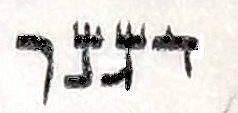Left foot of gimel #2
In regard to the question in the last post - can it be that a ois that is kosher for sfardim be pasul for ashkenazim (or opposite). The Shaarei Tshuva OC36 quotes Sfardi Poskim that csav ashkenaz is pasul for sfardim, since there are shinuyim between the csavim. He (the ST, I didn’t look up the seforim he quotes) doesn’t mention what/which shinuyim are m'akev, that are pasul for Bnei Sfarad. The Noda B'yehuda vol 1 YD 80 writes that changes in csav from what is written in BY as csav ashkenaz, isnt m'akev, since anything that isn't mentioned in the talmud, isnt m'akev (it isnt clear if the NB means that anything mentioned is always m'akev, or that at least what is mentioned may be m'akev - if the talmud says so ). The NB writes: notice that csav velish is different from csav ashkenaz. This meant that csav velish is accepted for an ashkenazi. (I would think this may argue with the ST mentioned). But this is a general statement - not every change...







